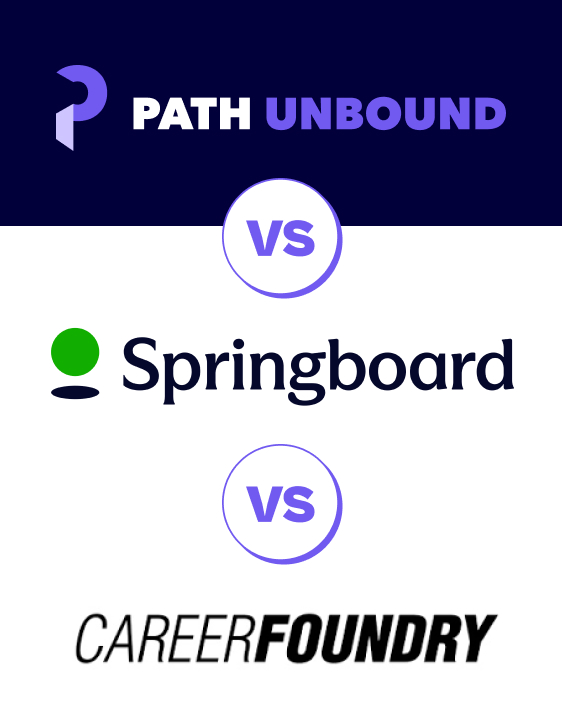The main difference between Springboard, CareerFoundry, and Path Unbound (Springboard vs. CareerFoundry vs. Path Unbound) lies in their different approach to education, course offerings, tuition, instructional methods, scholarships, career coaching, and portfolio building. In this article, we will dive deep to explain how they are different and which school is best for your design career needs.
1. Course Offerings: Springboard vs. CareerFoundry vs. Path Unbound
Springboard, CareerFoundry, and Path Unbound each offer a range of courses tailored to different aspects of technology and design, with distinct focuses and structures.
Springboard
Springboard’s course offerings cover various tech careers, from data science to machine learning. They provide comprehensive programs designed to equip students with in-demand skills.
- Data Science: Comprehensive programs from introductory to advanced levels.
- Software Engineering: Full-stack web development.
- UI/UX Design: Wireframing, prototyping, and user research.
- Cybersecurity: Prepares students for roles in cybersecurity.
- Data Analytics: Data analysis and business analytics.
- Machine Learning: Advanced course for ML engineer roles.
CareerFoundry
CareerFoundry focuses on design, development, and digital marketing, offering specialized courses with a career-oriented approach.
- UI Design: User interface design principles and tools.
- UX Design: Comprehensive UX design process, user research, and testing.
- Web Development: Front-end and back-end development.
- Data Analytics: Business analytics and data visualization.
- Digital Marketing: SEO, content marketing, and analytics.
Path Unbound
Path Unbound’s courses are detailed and design-centric, catering to aspiring and current UI/UX designers with a focus on practical skills and portfolio development.
- School of UI/UX Design: End-to-end program covering essential UI/UX topics, concluding with portfolio building.
- Portfolio School:
- Portfolio Kickstart: For students with design knowledge but no portfolio.
- Portfolio Express: For students with existing projects needing enhancement.
- Short Courses:
- Various design specializations such as Visual Design Foundation, Art Direction, Branding Design, and more.
- Monthly Subscription: On-demand learning for the School of UI/UX Design with optional instructor sessions.
Free Introductory Courses:
2. Tuition: Springboard vs. CareerFoundry vs. Path Unbound
The tuition fees for these programs vary, reflecting the depth and length of each course, as well as the support provided.
Springboard
Springboard’s tuition ranges from $5,500 to $8,500, with options for deferred tuition and monthly payments.
- Courses range from $5,500 to $8,500.
- Deferred tuition and monthly payment options available.
CareerFoundry
CareerFoundry’s courses are priced between $6,900 and $7,900, with flexible payment plans to suit different financial situations.
- Courses range from $6,900 to $7,900.
- Monthly payment plans available.
Path Unbound
Path Unbound offers various pricing options depending on the course and learning model.
- School of UI/UX Design: $6,800 for the full program; $25 per month for on-demand access.
- Short Courses: $499 to $599 per course; self-paced access with pay-as-you-go instructor sessions for $299.
- Portfolio School:
- Portfolio Express: $1,600
- Portfolio Kickstart: $2,800
3. Instructional Methods: Springboard vs. CareerFoundry vs. Path Unbound
The instructional methods used by these schools cater to different learning styles and preferences, ranging from self-paced learning to personalized mentorship.
Springboard
Springboard offers flexible, self-paced learning with personalized mentor support and real-world projects.
- Self-paced with flexible timelines.
- Weekly 1-on-1 mentor sessions.
- Project-based learning with real-world projects.
CareerFoundry
CareerFoundry provides a structured yet flexible learning path with a dual mentorship model and hands-on projects.
- Self-paced with structured milestones.
- Dual mentorship model: personal tutor and career specialist.
- Hands-on projects and assignments.
Path Unbound
Path Unbound’s instructional methods include weekly instructor sessions, focused portfolio coaching, and flexible learning options.
- School of UI/UX Design: Weekly 1-on-1 instructor sessions.
- Portfolio School: Focused portfolio coaching with weekly 1-on-1 instructor sessions.
- Short Courses: Self-paced with optional pay-as-you-go instructor sessions.
- Monthly Subscription: On-demand, self-paced learning with optional instructor support.
4. Scholarships: Springboard vs. CareerFoundry vs. Path Unbound
Scholarships can significantly reduce the financial burden of these programs. Each platform offers different scholarship opportunities.
Springboard
Springboard offers limited scholarships aimed at promoting diversity in tech.
- Limited scholarships available for underrepresented groups in tech.
CareerFoundry
CareerFoundry provides partial scholarships to support inclusivity in the tech industry.
- Partial scholarships for women in tech and other underrepresented groups.
Path Unbound
Path Unbound offers scholarships that can reduce tuition by up to 30%, making their programs more accessible.
- Scholarships awarding up to 30% off tuition.
5. Career Coaching: Springboard vs. CareerFoundry vs. Path Unbound
Effective career coaching is crucial for transitioning into a new career. Each school offers robust career support services.
Springboard
Springboard provides comprehensive career services, including personalized coaching and job placement support.
- Comprehensive career services: resume review, LinkedIn optimization, job placement support.
- Dedicated career coach.
CareerFoundry
CareerFoundry offers career coaching with a focus on job search support, resume and LinkedIn profile review, and interview preparation.
- Career specialists for job search support.
- Resume and LinkedIn profile review.
- Interview preparation.
Path Unbound
Path Unbound integrates career coaching into its programs, with a strong focus on portfolio development and personal branding.
- Career coaching integrated into the programs.
- Emphasis on building a professional portfolio and personal branding.
6. Portfolio Building: Springboard vs. CareerFoundry vs. Path Unbound
A strong portfolio is essential for design careers. Each platform emphasizes portfolio building to different extents.
Springboard
Springboard ensures students graduate with a professional portfolio through project-based learning and capstone projects.
- Project-based approach with real-world assignments.
- Capstone projects to showcase skills.
CareerFoundry
CareerFoundry focuses on hands-on projects to help students build a professional portfolio, with reviews by mentors and career specialists.
- Hands-on projects for portfolio development.
- Portfolio reviews by mentors and career specialists.
Path Unbound
Path Unbound places a significant emphasis on portfolio building, especially through their Portfolio School and dedicated portfolio coaching.
- School of UI/UX Design: Rigorous portfolio coaching as part of the curriculum.
- Portfolio School:
- Portfolio Kickstart: Develops a complete portfolio from scratch.
- Portfolio Express: Enhances existing projects and personal branding.
Which One to Choose?
Choosing the right program depends on your career goals, learning preferences, and budget.
- Springboard is ideal for those seeking a wide range of tech-focused courses and robust career support.
- CareerFoundry is suited for students who prefer a dual mentorship model and a structured, step-by-step learning approach.
- Path Unbound is perfect for aspiring UI/UX designers who want a comprehensive design education with a strong emphasis on portfolio building.
When Should You Choose Path Unbound?
Choose Path Unbound if you:
- Are focused on a career in UI/UX design and want an end-to-end program that covers every necessary skill.
- Need dedicated portfolio coaching to create a professional and standout portfolio.
- Prefer flexible learning options, such as short courses or a monthly subscription model with on-demand support.
- Are looking for a program that offers scholarships to reduce tuition costs.
And finally, if you are unsure if getting into UI/UX design is still a good idea with massive tech layoffs, we made a short video for you discussing this issue:




